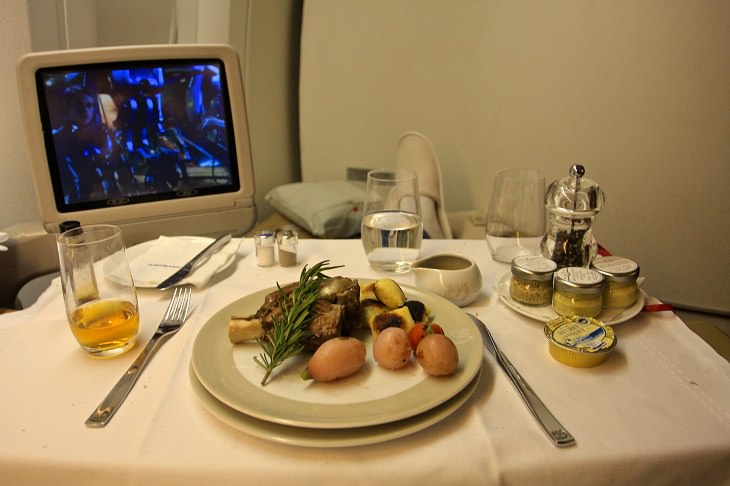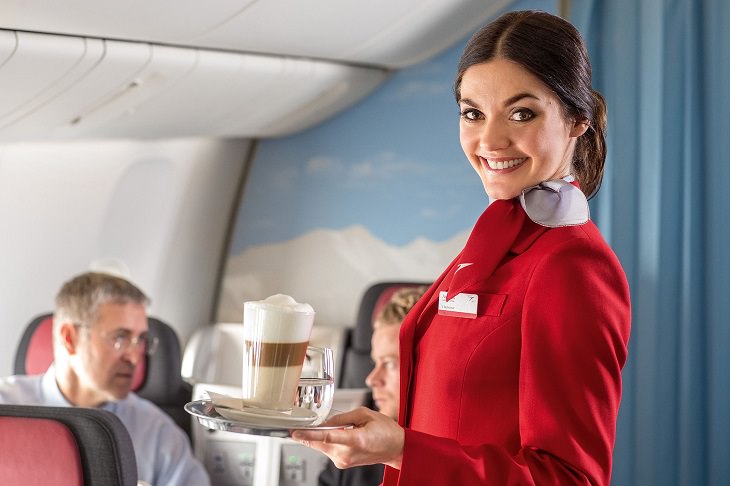
Airplane food is certainly notorious, with the number of people boarding a flight and not complaining about the food by the end of it can be counted on one hand. With that being said, we must admit that most of us still eat the food served because what other choice do we have? We are in the air, the flight lengthens, and the hunger and boredom begin to sink in until finally, the in-flight meal starts looking like an attractive option...
But if you are already eating airplane food and drinking the drinks served as well, you may very well want to be aware of what you should eat and what you should avoid. For this purpose, we’ve prepared a list of 9 important tips regarding food and drinks on airplanes.
If you've ever entertained the illusion that airplane food was prepared in the airline's top kitchen, where the best chefs cook for you, then know that this is a pretense that has nothing to do with reality. The food in the aircraft is 100% industrial and prepared in huge kitchens adjacent to the airport which serve many airlines at the same time. In these kitchens, the largest of which are located in Switzerland, Germany and Dubai, hundreds of thousands of dishes are sold daily to dozens of airlines, with the value of this thriving industry touching 10 billion euros a year. The food for the flights is prepared and packed by the kitchens’ production workers and machinery, loaded with the other 40,000 items that are loaded on to it every flight, and then reheated by flight attendants.
Many dishes served in the air carry the label "fresh" but know that the truth is far from what the label proposes and that meals can go through quite a long journey until they reach the tray in front of you. Most meals served on the plane are produced long before they are served to the passengers. Meals are usually prepared, in the same kitchens that we discussed in the previous section, between 12 and 72 hours before the flight.
The salads, desserts, pastries, plastic cutlery and the napkins that are served on the flight are packed after being prepared and placed inside the boxes intended for them until they are loaded onto the plane just before takeoff. The hot meals are prepared in large pots, then moved to plastic containers, covered with aluminum foil, and are shock frozen at 5 degrees Celsius for about an hour and a half, and then packed into large metal boxes until they are delivered to the plane before taking off.

When the flight attendants reach your row and ask “chicken or beef?” there is only one way to ensure you get a meal that isn’t too dry or bland: find out which of the options contains more sauce. The explanation is simple: meat stews cooked in a sauce, as well as liquid dishes such as soup, are the best options when you are on the plane because they are filled with rich and spicy flavors that compensate for the meager taste of the other dishes served on the flight.
Also, choose dishes that include tomatoes, mushrooms or Parmesan cheese, ingredients that’ll make your food more palatable, without the need to add too much salt. On the other hand, avoid noodles, pasta, rice or fried foods because they tend not to keep a uniform texture when reheated on the flight and become a big tasteless lump.
First class passengers tend to think that, unlike Economy, they get their food fresh and cooked on the spot, because it is served in elaborate, fancy dishes with metal cutlery, sometimes accompanied by a rather persuasive plating ceremony by the polite hostesses. However, this is only an illusion because even the food served in first class is cooked and prepared on the ground, in the very same kitchens where economy class meals are cooked.
Airline chefs take care to prepare a guide for the plane's crew, which teaches them how to serve the food in a more convincing and enjoyable manner that will make the passenger believe they are getting good quality food. In addition, there is also the issue of serving with metal cutlery, which has been shown to have a completely psychological effect on the taste of food. In other studies, people who dined with metal cutlery rated the quality of the portions served as 10% better than people who ate the same food with plastic cutlery. Therefore, the illusion that first-class food is better is merely psychological and airlines know and take advantage of this fact, meaning that there’s really no point in buying a first-class ticket if you only want to eat better.

Until now we’ve talked about the external factors, such as how the food is prepared and how it’s made to look better, which leads to the not so great taste of most of the meals served on flights, but know that the bad taste is not necessarily due to the quality of the food served to us, but also because of the physical conditions we are in; At 30,000 feet above ground, air pressure is very low and humidity drops to less than 12 percent. These factors make our nose dry and our taste buds become numb, which makes assessing the true quality of our food a challenging task.
In a study conducted in 2010, it was found that when on a plane, our ability to taste salt plummets by 30 percent, and the ability to taste sweetness is 20 percent lower than when we are on the ground. So, the next time you board a flight, bring a little salt and pepper in a bag and sprinkle some on your meal to add flavor and compensate for what was lost due to the difference in altitude.
The sparse air pressure in the passenger cabin causes water to boil at a temperature of only 90 degrees, as opposed to the 100 degrees required for it to reach a boil on the ground, and as a result, the flavor of hot drinks served becomes somewhat tasteless. In addition, the water that is poured into the coffee or tea served to you is not always bottled mineral water, but rather comes from the planes water system, which isn’t necessarily cleaned thoroughly between flights, especially if layover times are short.

It may be a bit startling and surprising to hear, but the folding tray, attached to the back of the chair in front of you, is considered the dirtiest surface on the plane, with more bacteria on it than on the toilet seat in the bathroom. Unfortunately, airlines do not take much care in cleaning it, so it is important that you bring a wad of wipes with you and thoroughly wipe it down before eating your meal on it. Also, don’t place your personal items on it, and certainly refrain from placing any food you are about to put in your mouth on it, whether served during or after the meal.
If you drink alcoholic beverages on the plane - beers, wines, liqueurs or anything else offered by flight attendants - experts recommend that you do so early in the flight before your taste buds dry up due to the air pressure. If you are among the people who like to sip wine on the flight, know that wine that normally tastes good on the ground can lose its taste completely when in the air. Therefore, experts recommend, ordering high-quality wines, such as Argentinian wine, which is produced at 1,500 meters above sea level, where air pressure is similar to the pressure in the passenger compartment.
Champagne and sparkling wines are an even better option for drinking on an airplane, because the flavor distribution mechanism is different from that of regular wines, and the bubbles that rise up the nose and mouth allow the body to taste and smell despite air pressure conditions. In any case, it is important to remember that low air pressure on the plane causes blood thinning in the body, which can lead to alcohol levels being higher in the air than on the ground, so it is strongly recommended to avoid overdoing it with the drinks when flying.
